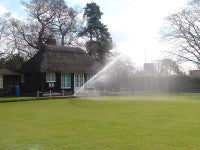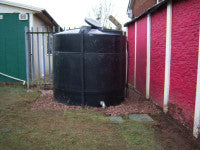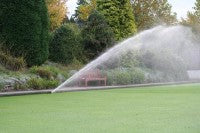Irrigation or irritation?
 How many of you responsible for maintaining a bowling green have thought that an irrigation system would make life so much easier, by reducing the enormous man hours used up watering in the summer months? And how many of you presume that one system is pretty much like the next, with cost being the contributory factor when choosing a system?
How many of you responsible for maintaining a bowling green have thought that an irrigation system would make life so much easier, by reducing the enormous man hours used up watering in the summer months? And how many of you presume that one system is pretty much like the next, with cost being the contributory factor when choosing a system?
Well, you'd be correct in the first instance, with an automatic pop up system taking about sixty minutes a night to apply all the water you will need to keep the green in tip top condition. The water can be applied in your absence in the early hours of the morning, reducing water wastage through evaporation and ensuring that the whole green is covered evenly and effectively.
You'd also be right in the second instance in that cost of the system has to be a contributory factor in any decision made as to what type of system or which contractor you employ to install it. However, cost can only be compared if all of your options are based around an efficient, reliable and well specified set of proposals.
Time after time, I have been involved in conversations with members from various bowling clubs who have done what they presumed to be the right thing, and opted for a system that appears to be the least expensive, only to find that the pop ups don't cover, or the control panel doesn't operate to their requirements. Or, worst of all, the system has just given up after only a short period, usually just after the warranty has expired!
The end result of these conversations usually concludes with the club having to shell out large sums of money (on top of their initial investment) just to get some form of acceptable operation.
These types of issues are easily avoided if the club follows some simple rules based around good design and installation practice. Over the course of this article I hope to cover the key items that any club looking to invest in a system should be aware of and, therefore, seriously reduce the risk of disappointment further down the line.
Storage tanks
 Certain components of an irrigation system are obviously visible and can lead to much discussion at the time of enquiry, with the storage tank probably being the most obvious.
Certain components of an irrigation system are obviously visible and can lead to much discussion at the time of enquiry, with the storage tank probably being the most obvious.
Storage tanks come in many shapes and sizes and can be constructed of numerous types of compounds. Generally, tank specification should follow a very basic criteria, that being that the tank should (where possible) be capable of holding at least one night's water requirement.
This way any future problems with water supply can be managed in the knowledge that you have a sufficient water to see you through the short term problem.
Tanks should be made of a material that is going to last the lifetime of the system and not be susceptible to weather damage.
Most important of all, when specifying a tank type, you must be certain that the tank can satisfy any regulations laid down by your local water supplier, such as regulation air gaps, suitable overflows and acceptable composite.
If installed correctly the storage tank is the only part of the system which is directly connected to the potable or town water supply and, as such, falls under all regulations enforced by the water provider. Incorrect installation or product type could result in a prohibition order from the water supply company.
Many clubs choose to supply their own tank, usually because a benefactor has offered to supply a unit at no cost. This is a sensible way to save on system costs but old style metal tanks should be avoided as, generally, there is no way of knowing what has been stored in them in the past, and they are susceptible to corrosion internally, resulting in rust entering the system and blocking up pumps and control valves.
Pumping unit
The pumping unit is the heart of the irrigation system, and is probably the most commonly under specified component that we come across when investigating operational problems.
Pumps will vary massively in their duty, and the cost savings to the contractor by just stepping down one model can be huge. As an example, there can be as much as £200 difference on list price between a 2.2Kw pump and a 1.5Kw pump, both made by the same manufacturer and both from the same model range, but both with massively differing performance.
Pump specification can be quite complicated but, put simply, the pump must be capable of operating the sprinkler at the required manufacturer's running pressure and flow, taking into account any static lift on site and all friction losses in the pipe line and fittings. Any contractor worth his salt should be able to explain and justify his pump choice to you, discussing required flows and pressures. Always ask to see the pump brochure and ask for the pump curve to be explained and justified.
 If you have 3-phase power on site always take advantage of this and insist that your contractor installs a 3-phase pump as, generally, these units are cheaper to buy than the single phase equivalent. More importantly, power consumption will always be less, saving money on running costs.
If you have 3-phase power on site always take advantage of this and insist that your contractor installs a 3-phase pump as, generally, these units are cheaper to buy than the single phase equivalent. More importantly, power consumption will always be less, saving money on running costs.
It is always preferable to allow at least 10% over specification on a pump unit, as, over time, the efficiency of a pump will wane and, if no allowance is made for this performance, the sprinklers will be visibly affected.
It should always be possible to hydraulically isolate the pump from the system and a pressure gauge should always be installed. A system installed without a pressure gauge is 'running blind' with no way of knowing how the pump is performing or reacting to the required flow of water.
The control valve assembly must always include some kind of pressure relief system in place, this will insure that the pump cannot over pressure the system or be damaged by running against a closed head.
Finally, the current trend seems to be to install submersible pumps within the tank instead of an above ground vertical unit next to the tank. This type of installation makes sense in that less overall space is required to house the system and the chances of the pump being damaged or vandalised are massively reduced.
The pumps used have generally been designed by the manufacturer to work within a borehole, so always get your contractor to confirm that the pump is suitable for horizontal use (not all are) and that a shroud is fitted around it to prevent the motor from overheating, as simply being submerged in water is often not enough to ensure long term operation. If you are unsure of any answers offered by the installer, phone the pump manufacturer and they will readily advise of the correct procedure.
Over the course of the next couple of articles we will discuss pipe type and sizing, sprinkler specification and manufacture and controller types and switches. If you need further information on any of the above or can't wait for the next article to answer your enquiry, please feel free to email your questions to editor@pitchcare.com
